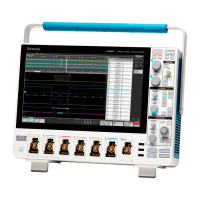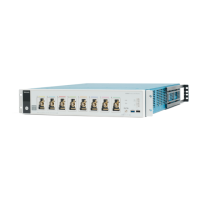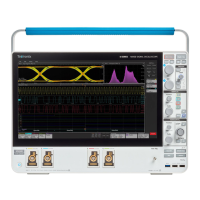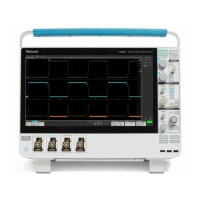Field or control Description
Fast Channel 2 Sets the condition and value of the fast channel 2 data on which to trigger.
T
ap the down arrow and select the condition on which to trigger (=, ≠, >, <, ≥, ≤). The default is =.
Tap the Binary or Hex field and use the A and B knobs to select and change the values. Or double-tap
on the field and use the virtual keypad to enter values.
Available when Trigger On = Fast Channel.
Message ID Sets the value of the message ID data on which to trigger.
Available when Trigger On = Slow Channel.
Data Sets the condition and value of the slow channel data on which to trigger.
Tap the down arrow and select the condition on which to trigger (=, ≠, >, <, ≥, ≤). The default is =.
Tap the Binary or Hex field and use the A and B knobs to select and change the values. Or double-tap
on the field and use the virtual keypad to enter values.
Available when Trigger On = Slow Channel.
Low Value, High Value Sets the highest and lowest range of the number of data on which to trigger.
Tap the Low Value or High Value field and use the A and B knobs to set the values.
Available when Trigger On = Fast Channel and Fast Channel 1 or Fast Channel 2 = Inside Range
or Outside Range.
Error Type Sets the error type on which to trigger. Tap the arrow and select the error condition.
Available when Trigger On = Error.
CRC Type Sets the CRC error type on which to trigger (Fast Channel or Slow Channel).
Available when Trigger On = Error and Error Type = CRC.
Mode & Holdoff panel (Bus Trigger configuration panel) fields and controls
Field or control Description
Trigger Mode The trigger mode determines how the instrument behaves in the absence or presence of a trigger
event:
Auto trigger mode enables the instrument to acquire and display a waveform even if a trigger does not
occur
. Auto mode uses a timer that starts when the acquisition is started, and the pretrigger information
is obtained. If a trigger event is not detected before the timer times out, the instrument forces a trigger.
The length of time it waits for a trigger event depends on the time base setting.
Normal trigger mode enables the instrument to acquire a waveform only when it is triggered. If no
trigger occurs, the last waveform record acquired remains on the display. If no last waveform exists, no
waveform is displayed.
Force Trigger Forces a trigger event regardless of whether the waveform meets any trigger conditions.
Holdoff Time Tap the Holdoff Time field and use the multipurpose knob to adjust the holdoff time value. Or
double-tap the field and use the virtual keypad to enter a time holdoff period. Trigger holdoff sets the
amount of time the oscilloscope waits after a trigger event before detecting and triggering on the next
trigger event. Use this option when the signal that you want to trigger on has several possible trigger
points or is a burst signal.
Table continued…
Menus and dialog boxes
228
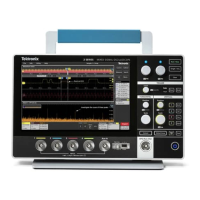
